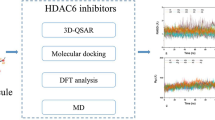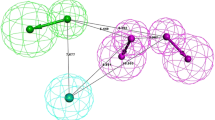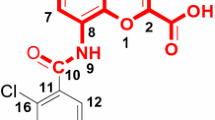Abstract
Three-dimensional quantitative structure–activity relationship studies were performed on a series of 88 histamine receptor 4 (H4R) antagonists in an attempt to elucidate the 3D structural features required for activity. Several in silico modeling approaches, including comparative molecular field analysis (CoMFA), comparative similarity indices analysis (CoMSIA), molecular docking, and molecular dynamics (MD), were carried out. The results show that both the ligand-based CoMFA model (Q 2 = 0.548, R 2ncv = 0.870, R 2pre = 0.879, SEE = 0.410, SEP = 0.386) and the CoMSIA model (Q 2 = 0.526, R 2ncv =0.866, R 2pre = 0.848, SEE = 0.416, SEP = 0.413) are acceptable, as they show good predictive capabilities. Furthermore, a combined analysis incorporating CoMFA, CoMSIA contour maps and MD results shows that (1) compounds with bulky or hydrophobic substituents at positions 4–6 in ring A (R2 substituent), positively charged or hydrogen-bonding (HB) donor groups in the R1 substituent, and hydrophilic or HB acceptor groups in ring C show enhanced biological activities, and (2) the key amino acids in the binding pocket are TRP67, LEU71, ASP94, TYR95, PHE263 and GLN266. To our best knowledge, this work is the first to report the 3D-QSAR modeling of these H4R antagonists. The conclusions of this work may lead to a better understanding of the mechanism of antagonism and aid in the design of new, more potent H4R antagonists.









Similar content being viewed by others
Abbreviations
- QSAR:
-
Quantitative structure–activity relationship
- 3D-QSAR:
-
Three-dimensional quantitative structure–activity relationship
- HR:
-
Histamine receptors
- H4R:
-
Histamine receptor 4
- GPCR:
-
G-protein-coupled receptor
- H4R:
-
Histamine receptor 4
- CADD:
-
Computer-aided drug design
- CoMFA:
-
Comparative molecular field analysis
- CoMSIA:
-
Comparative similarity index analysis
- MD:
-
Molecular dynamics
- HB:
-
Hydrogen bond
- RMSD:
-
Root mean square deviation
- SEE:
-
Standard error of estimates
- SEP:
-
Standard error of prediction
- Q 2 :
-
Cross-validated correlation coefficient after the leave-one-out procedure
- R 2ncv :
-
Non-cross-validated correlation coefficient
- F ratio of R 2ncv :
-
Explained to unexplained R 2ncv ratio = R 2ncv /(1 − R 2ncv )
- R 2pre :
-
Predicted correlation coefficient for the test set of compounds
- OPN:
-
Optimal number of principal components
- PLS:
-
Partial least squares
- PCs:
-
Principal components
- LOO:
-
Leave-one-out
References
Hsieh GC, Chandran P, Salyers AK, Pai M, Zhu CZ, Wensink EJ, Witte DG, Miller TR, Mikusa JP, Baker SJ, Wetter JM, Marsh KC, Hancock AA, Cowart MD, Esbenshade TA, Brioni JD, Honore P (2010) H4 receptor antagonism exhibits anti-nociceptive effects in inflammatory and neuropathic pain models in rats. Pharmacol Biochem Behav 95:41–50
Crane K, Shih DT (2004) Development of a homogeneous binding assay for histamine receptors. Anal Biochem 335:42–49
Smits RA, Leurs R, de Esch IJ (2009) Major advances in the development of histamine H4 receptor ligands. Drug Discov Today 14(15–16):745–753
Kiss R, Noszal B, Racz A, Falus A, Eros D, Keseru GM (2008) Binding mode analysis and enrichment studies on homology models of the human histamine H4 receptor. Eur J Med Chem 43:1059–1070
Hsieh GC, Chandran P, Salyers AK, Pai M, Zhu CZ, Wensink EJ, Witte DG, Miller TR, Mikusa JP, Baker SJ, Wetter JM, Marsh KC, Hancock AA, Cowart MD, Esbenshade TA, Brioni JD, Honore P (2009) H4 receptor antagonism exhibits anti-nociceptive effects in inflammatory and neuropathic pain models in rats. Pharmacol Biochem Behav 95:41–50
Lee-Dutra A, Arienti KL, Buzard DJ, Hack MD, Khatuya H, Desai PJ, Nguyen S, Thurmond RL, Karlsson L, Edwards JP, Breitenbucher JG (2006) Identification of 2-arylbenzimidazoles as potent human histamine H4 receptor ligands. Bioorg Med Chem Lett 16:6043–6048
Cramp S, Dyke HJ, Higgs C, Clark DE, Gill M, Savy P, Jennings N, Price S, Lockey PM, Norman D, Porres S, Wilson F, Jones A, Ramsden N, Mangano R, Leggate D, Andersson M, Hale R (2010) Identification and hit-to-lead exploration of a novel series of histamine H4 receptor inverse agonists. Bioorg Med Chem Lett 20:2516–2519
Zhang M, Thurmond RL, Dunford PJ (2007) The histamine H4 receptor: A novel modulator of inflammatory and immune disorders. Pharmacol Therapeut 113:594–606
Igel P, Geyer R, Strasser A, Dove S, Seifert R, Buschauer A (2009) Synthesis and structure–activity relationships of cyanoguanidine-type and structurally related histamine H4 receptor agonists. J Med Chem 52:6297–6313
Sander K, Kottke T, Tanrikulu Y, Proschak E, Weizel L, Schneider EH, Seifert R, Schneider G, Stark H (2009) 2,4-Diaminopyrimidines as histamine H4 receptor ligands—scaffold optimization and pharmacological characterization. Bioorg Med Chem 17:7186–7196
Jablonowski JA, Grice CA, Chai W, Dvorak CA, Venable JD, Kwok AK, Ly KS, Wei J, Baker SM, Desai PJ, Jiang W, Wilson SJ, Thurmond RL, Karlsson L, Edwards JP, Lovenberg TW, Carruthers NI (2003) The first potent and selective non-imidazole human histamine H4 receptor antagonists. J Med Chem 46:3957–3960
Altenbach RJ, Adair RM, Bettencourt BM, Black LA, Fix-Stenzel SR, Gopalakrishnan SM, Hsieh GC, Liu H, Marsh KC, McPherson MJ, Milicic I, Miller TR, Vortherms TA, Warrior U, Wetter JM, Wishart N, Witte DG, Honore P, Esbenshade TA, Hancock AA, Brioni JD, Cowart MD (2008) Structure–activity studies on a series of a 2-aminopyrimidine-containing histamine H4 receptor ligands. J Med Chem 51:6571–6580
Taft CA, Da Silva VB, Da Silva CH (2008) Current topics in computer-aided drug design. J Pharm Sci 97:1089–1098
Papa E, Battaini F, Gramatica P (2005) Ranking of aquatic toxicity of esters modelled by QSAR. Chemosphere 58:559–570
Gasteiger J, Marsili M (1980) Iterative partial equalization of orbital electronegativity—a rapid access to atomic charges. Tetrahedron 36:3219–3228
Artico M, Botta M, Corelli F, Mai A, Massa S, Ragno R (1996) Investigation on QSAR and binding mode of a new class of human rhinovirus-14 inhibitors by CoMFA and docking experiments. Bioorg Med Chem 4:1715–1724
Rao CR, Wu Y (2005) Linear model selection by cross-validation. J Stat Plan Infer 128:231–240
Wang X, Yang W, Xu X, Zhang H, Li Y, Wang Y (2010) Studies of benzothiadiazine derivatives as hepatitis C virus NS5B polymerase inhibitors using 3D-QSAR, molecular docking and molecular dynamics. Curr Med Chem 17:2788–2803
Zhu YQ, Lei M, Lu AJ, Zhao X, Yin XJ, Gao QZ (2009) 3D-QSAR studies of boron-containing dipeptides as proteasome inhibitors with CoMFA and CoMSIA methods. Eur J Med Chem 44:1486–1499
Wang Z, Li Y, Ai C, Wang Y (2010) In silico prediction of estrogen receptor subtype binding affinity and selectivity using statistical methods and molecular docking with 2-arylnaphthalenes and 2-arylquinolines. Int J Mol Sci 11:3434–3458
Li Y, Wang Y-H, Yang L, Zhang S-W, Liu C-H, Yang S-L (2005) Comparison of steroid substrates and inhibitors of P-glycoprotein by 3D-QSAR analysis. J Mol Struct 733:111–118
Xu M, Zhang A, Han S, Wang L (2002) Studies of 3D-quantitative structure–activity relationships on a set of nitroaromatic compounds: CoMFA, advanced CoMFA and CoMSIA. Chemosphere 48:707–715
Kovalishyn VV, Kholodovych V, Tetko IV, Welsh WJ (2007) Volume learning algorithm significantly improved PLS model for predicting the estrogenic activity of xenoestrogens. J Mol Graph Model 26:591–594
Nayana MR, Sekhar YN, Nandyala H, Muttineni R, Bairy SK, Singh K, Mahmood SK (2008) Insight into the structural requirements of proton pump inhibitors based on CoMFA and CoMSIA studies. J Mol Graph Model 27:233–243
Thaimattam R, Daga P, Rajjak SA, Banerjee R, Iqbal J (2004) 3D-QSAR CoMFA, CoMSIA studies on substituted ureas as Raf-1 kinase inhibitors and its confirmation with structure-based studies. Bioorg Med Chem 12:6415–6425
Shahlaei M, Madadkar-Sobhani A, Mahnam K, Fassihi A, Saghaie L, Mansourian M (2011) Homology modeling of human CCR5 and analysis of its binding properties through molecular docking and molecular dynamics simulation. Biochem Biophys Acta 1808:802–817
Sander T, Liljefors T, Balle T (2008) Prediction of the receptor conformation for iGluR2 agonist binding: QM/MM docking to an extensive conformational ensemble generated using normal mode analysis. J Mol Graph Model 26:1259–1268
Berendsen HJC, van der Spoel D, van Drunen R (1995) GROMACS: a message-passing parallel molecular dynamics implementation. Comput Phys Commun 91:43–56
Lindahl E, Hess B, van der Spoel D (2001) GROMACS 3.0: a package for molecular simulation and trajectory analysis. J Mol Model 7:306–317
van Aalten DM, Bywater R, Findlay JB, Hendlich M, Hooft RW, Vriend G (1996) PRODRG, a program for generating molecular topologies and unique molecular descriptors from coordinates of small molecules. J Comput Aided Mol Des 10:255–262
Barreca ML, Ortuso F, Iraci N, De Luca L, Alcaro S, Chimirri A (2007) Tn5 transposase as a useful platform to simulate HIV-1 integrase inhibitor binding mode. Biochem Bioph Res Co 363:554–560
Liu R, Li X, Li Y, Jin P, Qin W, Qi J (2009) Effective removal of rhodamine B from contaminated water using non-covalent imprinted microspheres designed by computational approach. Biosens Bioelectron 25:629–634
Niu C, Xu Y, Luo X, Duan W, Silman I, Sussman JL, Zhu W, Chen K, Shen J, Jiang H (2005) Dynamic mechanism of E2020 binding to acetylcholinesterase: a steered molecular dynamics simulation. J Phys Chem B 109:23730–23738
Berendsen HJC, Postma JPM, van Gunsteren WF, Hermans J (1981) In: B Pullman (ed) Intermolecular forces. Reidel, Dordrecht, pp 331–342
Parrinello M, Rahman A (1981) Polymorphic transitions in single crystals: a new molecular dynamics method. J Appl Phy 52:7182–7190
Lin J-H, Perryman AL, Schames JR, McCammon JA (2002) Computational drug design accommodating receptor flexibility: the relaxed complex scheme. J Am Chem Soc 124:5632–5633
Dixit A, Kashaw SK, Gaur S, Saxena AK (2004) Development of CoMFA, advance CoMFA and CoMSIA models in pyrroloquinazolines as thrombin receptor antagonist. Bioorg Med Chem 12:3591–3598
Ashek A, Cho SJ (2006) A combined approach of docking and 3D QSAR study of [beta]-ketoacyl-acyl carrier protein synthase III (FabH) inhibitors. Bioorg Med Chem 14:1474–1482
Politi A, Durdagi S, Moutevelis-Minakakis P, Kokotos G, Mavromoustakos T (2010) Development of accurate binding affinity predictions of novel renin inhibitors through molecular docking studies. J Mol Graph Model 29:425–435
Wang Y, Li Y, Ma Z, Yang W, Ai C (2010) Mechanism of microRNA–target interaction: molecular dynamics simulations and thermodynamics analysis. PLoS Comput Biol 6:e1000866
Acknowledgments
We gratefully acknowledge Armin Buschauer and his colleagues for providing us with the homology model of the H4R protein structure. This work is supported by the National Natural Science Foundation of China (grant no. 10801025).
Author information
Authors and Affiliations
Corresponding author
Electronic supplementary material
Below is the link to the electronic supplementary material.
ESM 1
(DOC 511 kb)
Rights and permissions
About this article
Cite this article
Liu, J., Li, Y., Zhang, HX. et al. Studies of H4R antagonists using 3D-QSAR, molecular docking and molecular dynamics. J Mol Model 18, 991–1001 (2012). https://doi.org/10.1007/s00894-011-1137-x
Received:
Accepted:
Published:
Issue Date:
DOI: https://doi.org/10.1007/s00894-011-1137-x




